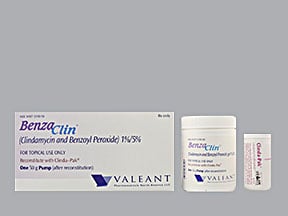
Benzaclin With Pump Coupons & Savings Card – Discount Prices from $298.23
My prescription
Edit
35GM of 1-5%, Benzaclin With Pump (1 Bottle)
Select pharmacy

CVS
$298.23
COUPON PRICE
Walmart
$298.82
COUPON PRICE
Walgreens
$309.81
COUPON PRICE
Albertsons
$450.39
COUPON PRICEFree Benzaclin With Pump Savings Card

CVS
$298.23
Show this coupon to your pharmacist
ID
LHC2D247EC
PCN
CHIPPO
BIN
019876
GRP
LHX
This coupon is not insurance
Price history for Benzaclin With Pump
1 Bottle, 35GM of 1-5%
Average retail price for Benzaclin With Pump
Average SaveHealth price for Benzaclin With Pump
Our price history data is based on aggregated prescription data collected from participating pharmacies in America. Our prescription data updates daily to reflect the latest price changes. If you notice a missing data point, it means there wasn't sufficient data available to generate a monetary value for that date.
*Retail prices are based on pharmacy claims data, and may not be accurate when we don't have enough claims.
Benzaclin With Pump dosage forms
Dosage Quantity Price from Per unit 35GM of 1-5% 1 Bottle $298.23 $298.23 35GM of 1-5% 2 Bottles $608.46 $304.23 35GM of 1-5% 3 Bottles $918.69 $306.23
| Dosage | Quantity | Price from | Per unit |
|---|---|---|---|
| 35GM of 1-5% | 1 Bottle | $298.23 | $298.23 |
| 35GM of 1-5% | 2 Bottles | $608.46 | $304.23 |
| 35GM of 1-5% | 3 Bottles | $918.69 | $306.23 |
Benzaclin With Pump Warnings
Benzaclin With Pump Side Effects
When using this medication, you might experience mild side effects such as dry skin, redness, burning, itching, or skin peeling. These are typically manageable, and applying moisturizing creams or lotions can help soothe these symptoms. However, if any of these effects persist or worsen, it is important to consult a healthcare professional. In rare instances, this drug can be absorbed into your bloodstream and lead to a severe intestinal condition caused by the bacteria C. difficile. This condition can develop during treatment or even weeks to months after treatment has ended. Be vigilant for symptoms like persistent diarrhea, abdominal or stomach pain, cramping, and blood or mucus in your stool. Avoid using anti-diarrhea or opioid products if these symptoms arise, as they can worsen the condition. On very rare occasions, a serious allergic reaction may occur. Seek immediate medical attention if you experience symptoms such as a rash, itching, swelling (particularly of the face, tongue, or throat), severe dizziness, or trouble breathing. While these severe effects are uncommon, being aware of them ensures prompt action if they arise. If you encounter any additional side effects not listed here, contacting a healthcare provider is advisable.
Benzaclin With Pump Interactions
What should I avoid while using BenzaClin?
While using BenzaClin, it is advisable to avoid the following:1. Sun Exposure: Minimize exposure to sunlight or artificial UV rays, such as tanning beds. BenzaClin can make the skin more sensitive to sunlight, increasing the risk of sunburn.2. Harsh Skin Products: Avoid using skin products that can cause irritation, such as harsh soaps, shampoos, or skin cleansers, hair coloring or permanent chemicals, hair removers or waxes, or skin products with alcohol, spices, astringents, or lime.3. Other Topical Acne Medications: Do not use other topical acne medications unless directed by a healthcare provider, as this can increase skin irritation.4. Contact with Eyes, Mouth, and Nose: Avoid getting BenzaClin in the eyes, mouth, or nose. If contact occurs, rinse thoroughly with water.5. Broken or Sunburned Skin: Do not apply BenzaClin to broken, sunburned, or irritated skin.Following these precautions can help reduce the risk of adverse effects while using BenzaClin.
Does clindamycin benzoyl peroxide gel make acne worse?
Clindamycin benzoyl peroxide gel is generally used to treat acne and is not typically known to make it worse. However, some individuals may experience initial irritation, redness, or dryness when starting treatment, which can temporarily make acne appear worse. These side effects often improve as the skin adjusts to the medication. If the condition worsens significantly or if there are concerns about side effects, it is advisable to consult a healthcare professional for further guidance.
What are the side effects of clindamycin and benzoyl peroxide?
Clindamycin and benzoyl peroxide, when used together, can cause several side effects. Common side effects may include dryness, peeling, redness, or irritation of the skin. Some individuals might experience itching or a burning sensation at the application site. Less commonly, it can cause gastrointestinal issues such as diarrhea or stomach pain. In rare cases, it may lead to an allergic reaction, which could present as a rash, itching, severe dizziness, or trouble breathing. If any severe side effects occur, it is important to seek medical attention promptly.
Does acne come back after benzaclin?
Acne can potentially return after discontinuing the use of Benzaclin. While Benzaclin is effective in treating acne by reducing bacteria and inflammation, it does not address the underlying causes of acne. Therefore, once treatment is stopped, acne may reappear, especially if the underlying factors such as hormonal changes or excess oil production persist. It is advisable to consult with a healthcare provider for a long-term acne management plan.
